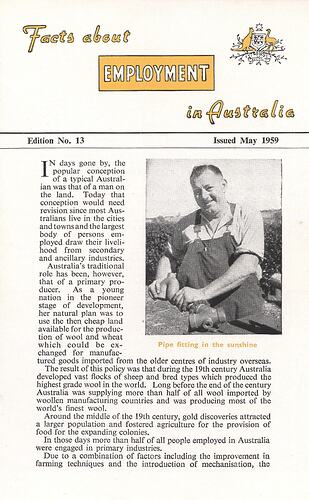Summary
Booklet titled 'Facts about Employment in Australia' published by the Australian News and Information Bureau, Australia House, London, May 1959. It was given to the Marshall/Taylor families as part of a collection of promotional material when they were arranging to migrate to Australia in 1960. 'Facts About' were a series of information booklets published during the 1950s and 1960s by the Australian Government for intending migrants, on subjects relating to living in Australia, including housing, education, sport, employment and women's issues.
In 1960 Lynne Marshall (now Carmichael), her brother Peter, parents Leslie and Irene and maternal grandparents George and Lillian Taylor all migrated to Australia from Gloucestershire, England. Her father had long been keen to come to Australia; her mother, fearful of ship travel, did not. Finally persuaded, they travelled from Tilbury dock on the 'Arcadia' having successfully applied for the 'nest egg' assistance scheme which guaranteed them a house in a new housing development in Elizabeth, South Australia. Her parents remained in their house for most of their lives, her grandparents having relocated early on to a house of their own. Uncertain of what they might find in Australia, they had packed a numerous domestic items and the early years were hard in a remote undeveloped suburb. The family never regretted their relocation, with health and education opportunities, but Lynne's parents were always to remain 'English to the core'. Lynne moved to Melbourne with her husband in 1997 for employment reasons.
Physical Description
Booklet of 8 pages of text, photos and graphics printed on white paper in black and yellow ink. Stapled. Front cover features a black and white photograph of a man in overalls fitting a pipe in an outdoor setting.
Significance
The Australian Government published a wide range of materials in order to both inform and entice prospective migrants from Europe and particularly the United Kingdom to Australia. 'Facts About' was a popular series circulated during the 1950s and 1960s and offers interesting insights into the ways in which the Government presented Australia's social, economic and cultural advantages during those relatively prosperous post-war years. They also reflect the social role and attitudes towards women, generally accepted views on family, domestic life and the emphasis on sport, climate and outdoor living.
More Information
-
Collecting Areas
-
Acquisition Information
Donation from Lynne Carmichael, 16 Jun 2011
-
Publisher
Department of Immigration, London, England, Great Britain, May 1959
-
Printer
C.F. Hodgson & Son Ltd., London, England, Great Britain, May 1959
-
Inscriptions
Title: Facts about/EMPLOYMENT/in Australia [Extensive text]
-
Classification
-
Category
-
Discipline
-
Type of item
-
Overall Dimensions
128 mm (Width), 203 mm (Height)
-
Keywords
Assisted Immigration, British Immigration, Employment, Immigration, Migration & Settlement, Promotional Materials, Working Conditions, Working Life

